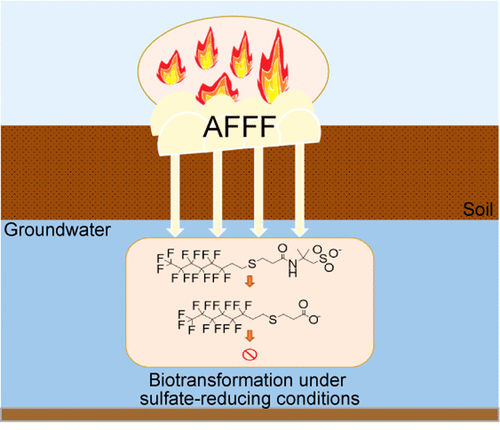当前位置:
X-MOL 学术
›
Environ. Sci. Technol. Lett.
›
论文详情
Our official English website, www.x-mol.net, welcomes your feedback! (Note: you will need to create a separate account there.)
Biotransformation of AFFF Component 6:2 Fluorotelomer Thioether Amido Sulfonate Generates 6:2 Fluorotelomer Thioether Carboxylate under Sulfate-Reducing Conditions
Environmental Science & Technology Letters ( IF 10.9 ) Pub Date : 2018-04-04 00:00:00 , DOI: 10.1021/acs.estlett.8b00148 Shan Yi 1 , Katie C. Harding-Marjanovic 2 , Erika F. Houtz 3 , Ying Gao 4 , Jennifer E. Lawrence 1 , Rita V. Nichiporuk 5 , Anthony T. Iavarone 5 , Wei-Qin Zhuang 6 , Martin Hansen 7 , Jennifer A. Field 8 , David L. Sedlak 1 , Lisa Alvarez-Cohen 1, 9
Environmental Science & Technology Letters ( IF 10.9 ) Pub Date : 2018-04-04 00:00:00 , DOI: 10.1021/acs.estlett.8b00148 Shan Yi 1 , Katie C. Harding-Marjanovic 2 , Erika F. Houtz 3 , Ying Gao 4 , Jennifer E. Lawrence 1 , Rita V. Nichiporuk 5 , Anthony T. Iavarone 5 , Wei-Qin Zhuang 6 , Martin Hansen 7 , Jennifer A. Field 8 , David L. Sedlak 1 , Lisa Alvarez-Cohen 1, 9
Affiliation

|
The fate of per- and polyfluoroalkyl substances (PFASs) in aqueous film-forming foams (AFFFs) under anaerobic conditions has not been well characterized, leaving major gaps in our understanding of PFAS fate and transformation at contaminated sites. In this study, the biotransformation of 6:2 fluorotelomer thioether amido sulfonate (6:2 FtTAoS), a component of several AFFF formulations, was investigated under sulfate-reducing conditions in microcosms inoculated with either pristine or AFFF-impacted solids. To identify the transformation products, we used high-resolution mass spectrometry and employed suspect-screening and nontargeted compound identification methods. These analyses demonstrated that 6:2 FtTAoS was transformed primarily to a stable polyfluoroalkyl compound, 6:2 fluorotelomer thioether propionate (6:2 FtTP). It did not undergo further reactions to produce the perfluoroalkyl carboxylates and fluorotelomer sulfonates and carboxylates that were observed during aerobic transformations. Here, the 6:2 FtTP was recalcitrant to biotransformation, indicating the stability of the thioether group under sulfate-reducing conditions. The total oxidizable precursor (TOP) assay was used to assess the presence of other PFASs. Although nearly all of the PFAS mass initially present was recovered from the pristine microcosms, only 67% of the initial PFAS mass was recovered from the contaminated microcosms, suggesting the formation of volatile biotransformation products or those that could not be detected by the TOP assay.
中文翻译:

AFFF组分6:2含氟调聚物硫醚酰胺基磺酸盐的生物转化在硫酸盐还原条件下生成6:2含氟调聚物硫醚羧酸盐
在厌氧条件下,水性成膜泡沫(AFFF)中全氟烷基物质和多氟烷基物质(PFAS)的命运尚未得到很好的描述,这使我们对PFAS命运和在受污染场所的转化的理解存在重大差距。在这项研究中,在硫酸盐还原条件下,在接种了原始或受AFFF影响的固体的微观世界中,研究了6:2氟调聚物硫醚酰胺基磺酸盐(6:2 FtTAoS)的生物转化,这是几种AFFF制剂的组成部分。为了鉴定转化产物,我们使用了高分辨率质谱法,并采用了可疑筛选和非目标化合物鉴定方法。这些分析表明,6:2 FtTAoS主要转化为稳定的多氟烷基化合物,即6:2氟调聚物硫醚丙酸酯(6:2 FtTP)。在需氧转化过程中未观察到产生全氟烷基羧酸盐,氟调聚物磺酸盐和羧酸盐的进一步反应。在这里,6:2 FtTP难于生物转化,表明硫醚基团在硫酸盐还原条件下的稳定性。总可氧化前体(TOP)分析用于评估其他PFAS的存在。尽管最初存在的几乎所有PFAS物质几乎都从原始微观世界中回收了,但最初PFAS初始物质中只有67%从受污染的微观世界中恢复了,这表明形成了挥发性生物转化产物或无法通过TOP分析检测到。在这里,6:2 FtTP难于生物转化,表明硫醚基团在硫酸盐还原条件下的稳定性。总可氧化前体(TOP)分析用于评估其他PFAS的存在。尽管最初存在的几乎所有PFAS物质几乎都从原始微观世界中回收了,但最初PFAS初始物质中只有67%从受污染的微观世界中恢复了,这表明形成了挥发性生物转化产物或无法通过TOP分析检测到。在这里,6:2 FtTP难于生物转化,表明硫醚基团在硫酸盐还原条件下的稳定性。总可氧化前体(TOP)分析用于评估其他PFAS的存在。尽管最初存在的几乎所有PFAS物质几乎都从原始微观世界中回收了,但最初PFAS初始物质中只有67%从受污染的微观世界中恢复了,这表明形成了挥发性生物转化产物或无法通过TOP分析检测到。
更新日期:2018-04-04
中文翻译:

AFFF组分6:2含氟调聚物硫醚酰胺基磺酸盐的生物转化在硫酸盐还原条件下生成6:2含氟调聚物硫醚羧酸盐
在厌氧条件下,水性成膜泡沫(AFFF)中全氟烷基物质和多氟烷基物质(PFAS)的命运尚未得到很好的描述,这使我们对PFAS命运和在受污染场所的转化的理解存在重大差距。在这项研究中,在硫酸盐还原条件下,在接种了原始或受AFFF影响的固体的微观世界中,研究了6:2氟调聚物硫醚酰胺基磺酸盐(6:2 FtTAoS)的生物转化,这是几种AFFF制剂的组成部分。为了鉴定转化产物,我们使用了高分辨率质谱法,并采用了可疑筛选和非目标化合物鉴定方法。这些分析表明,6:2 FtTAoS主要转化为稳定的多氟烷基化合物,即6:2氟调聚物硫醚丙酸酯(6:2 FtTP)。在需氧转化过程中未观察到产生全氟烷基羧酸盐,氟调聚物磺酸盐和羧酸盐的进一步反应。在这里,6:2 FtTP难于生物转化,表明硫醚基团在硫酸盐还原条件下的稳定性。总可氧化前体(TOP)分析用于评估其他PFAS的存在。尽管最初存在的几乎所有PFAS物质几乎都从原始微观世界中回收了,但最初PFAS初始物质中只有67%从受污染的微观世界中恢复了,这表明形成了挥发性生物转化产物或无法通过TOP分析检测到。在这里,6:2 FtTP难于生物转化,表明硫醚基团在硫酸盐还原条件下的稳定性。总可氧化前体(TOP)分析用于评估其他PFAS的存在。尽管最初存在的几乎所有PFAS物质几乎都从原始微观世界中回收了,但最初PFAS初始物质中只有67%从受污染的微观世界中恢复了,这表明形成了挥发性生物转化产物或无法通过TOP分析检测到。在这里,6:2 FtTP难于生物转化,表明硫醚基团在硫酸盐还原条件下的稳定性。总可氧化前体(TOP)分析用于评估其他PFAS的存在。尽管最初存在的几乎所有PFAS物质几乎都从原始微观世界中回收了,但最初PFAS初始物质中只有67%从受污染的微观世界中恢复了,这表明形成了挥发性生物转化产物或无法通过TOP分析检测到。


























 京公网安备 11010802027423号
京公网安备 11010802027423号